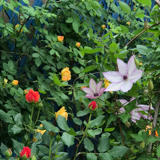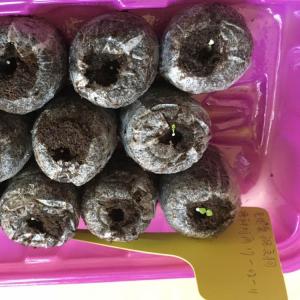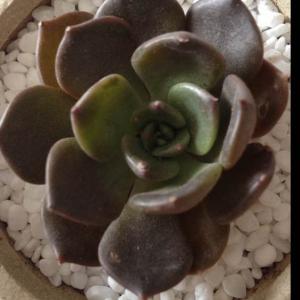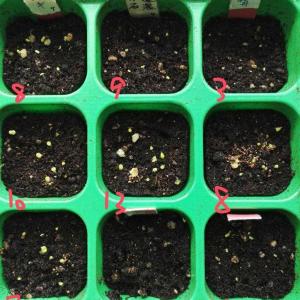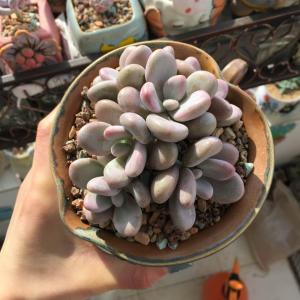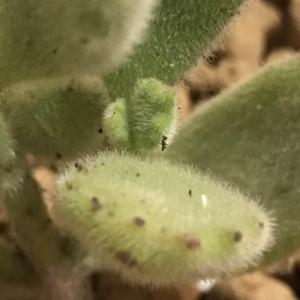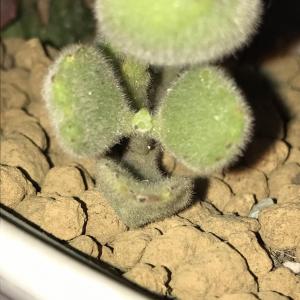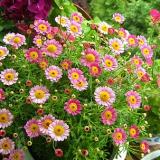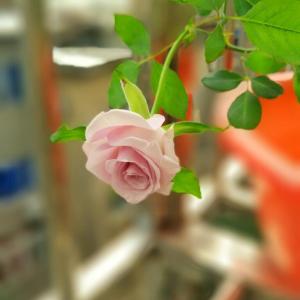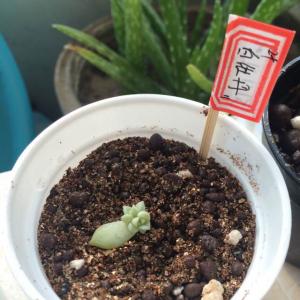文章
Andy
2017年02月15日

Starting an indoor herb garden? Find out 11 best herbs to grow indoors. These are easiest to grow and require less care.
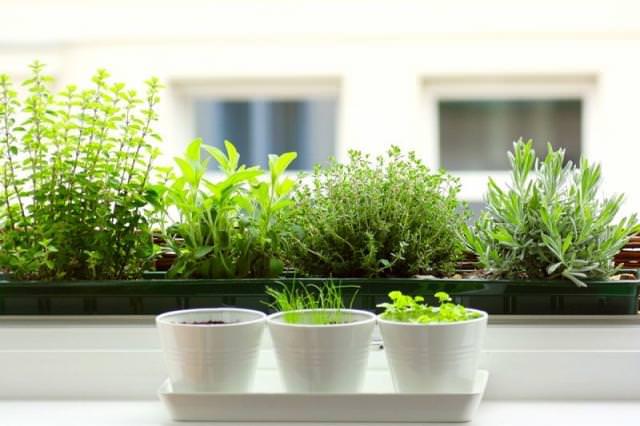
Best Herbs to Grow Indoors in Less Sun
1. Lemongrass
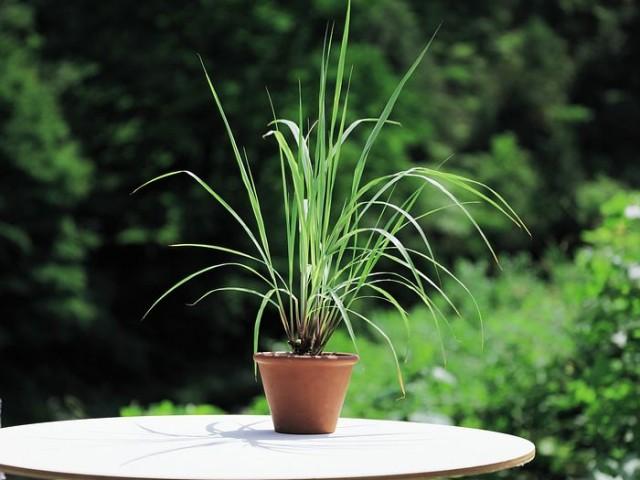
This herb grows wild in tropics and becomes easiest indoor herb, you can also grow it in temperate climates. It requires slightly moist soil and partial sun, and it can even adjust itself in a small container.
2. Mint
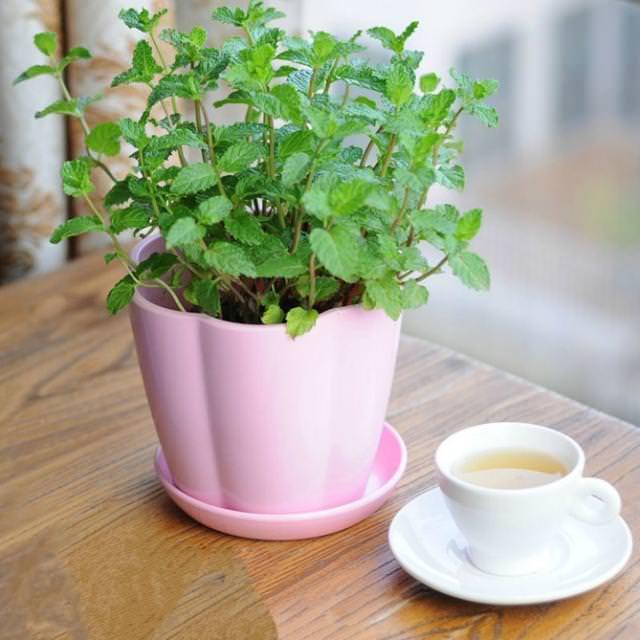
In the garden, mint becomes very invasive and grows like a weed. It doesn’t require plenty of sun too. You can even keep your potted mint plant in a spot that receives bright indirect sun.
3. Parsley

Germinate parsley from seeds, seedlings may sprout up late, sometimes in a month. But once grown, parsley requires minimal attention. Grow it in a medium-large pot and keep that in a spot that receives part sun. In a moderate room temperature, you can grow it year round. Just propagate new plants time to time from cuttings and it will last forever in your indoor herb garden.
4. Chives

Herbs that require less sunlight and moist soil in order to thrive are most suitable for growing indoors. Chives doesn’t require a sunny spot. Just place the pot near a bright window facing east. You can multiply chives from an already established plant by division.
5. Garden Cress

You can grow this cool season annual indoors easily. Plant seeds in a shallow but wide containers and keep the pot on a windowsill that receives partial sun. Soil should be moist, for regular harvest of cress micro greens, plant seeds in interval of every two weeks. You can cut and harvest the garden cress 3-4 times. If there is no sun, you can grow it under fluorescent lamps and T5 fluorescent plant lights.
6. Catnip
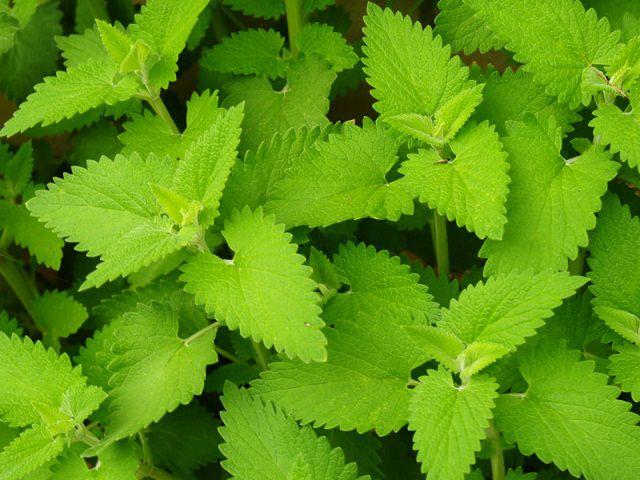
Growing catnip indoors is hard if you have cats. Apart from that, it is one of the easiest herbs. Once you germinate seeds, you can grow it forever from cuttings. Place the pot on a sunny windowsill and keep it well watered.
7. Lemon Balm

Lemon balm grows year round in warmer zones. Some gardeners even consider it a weed. Growing lemon balm indoors is super easy if you can provide it an exposure to 4 hours of sunlight daily. When growing indoors, water the plant only when top soil is dry.
8. Chervil
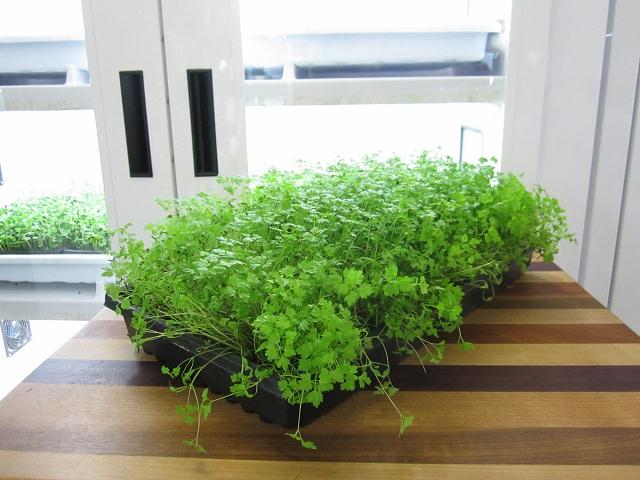
Chervil is one of the herbs you can grow indoors smoothly. A room temperature around 60-70 F is optimum for it. It can also adapt to low light conditions.
Best Herbs to Grow Indoors in More Sun9. Dill
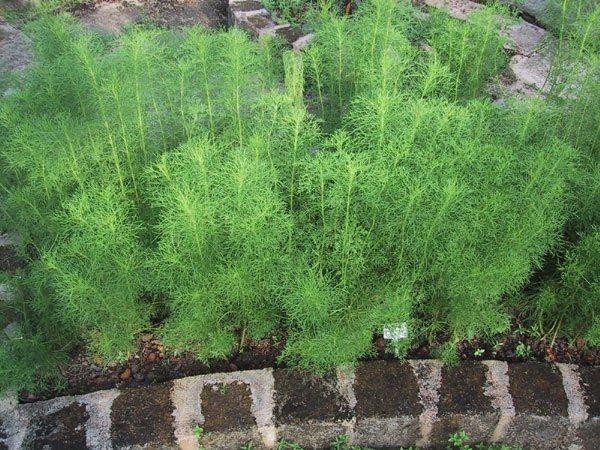
The secret of growing dill successfully in a container is to grow it in a deep one. A minimum 10 inches deep container is required. For growing dill indoors keep it in a spot that receives at least 5 hours of sunlight daily, provide good air circulation and water it only when top 1 inch surface of potting soil seems dry.
9. Cilantro

Image Credit: Gardening Know How
Cilantro is extremely easy to germinate but hard to maintain in containers. The trick is to grow cilantro in a deep container. It bolts quickly so it is better to plant seeds time to time. Keep cilantro in the south or west facing window.
10. Sage
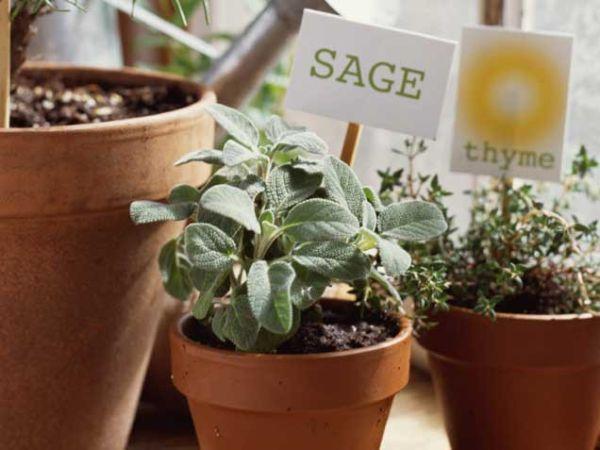
Grow sage indoors only if you have a South or West facing window that receives plenty of sun. This perennial herb takes a lot of time to get established when grown from seeds so it is better to take a tip cutting and propagate it.
11. Thyme
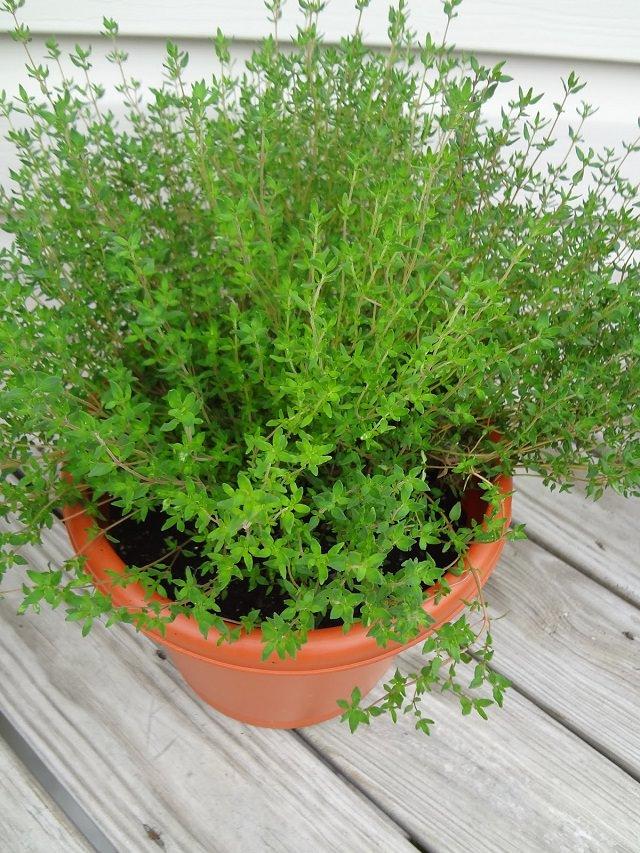
Thyme can adjust itself to partial sun and if you can provide 5 hours of sunlight daily, growing thyme indoors is possible.
A few more herbs you can grow indoors on a sunny windowsillOreganoRosemaryTarragonBasil

Best Herbs to Grow Indoors in Less Sun
1. Lemongrass

This herb grows wild in tropics and becomes easiest indoor herb, you can also grow it in temperate climates. It requires slightly moist soil and partial sun, and it can even adjust itself in a small container.
2. Mint

In the garden, mint becomes very invasive and grows like a weed. It doesn’t require plenty of sun too. You can even keep your potted mint plant in a spot that receives bright indirect sun.
3. Parsley

Germinate parsley from seeds, seedlings may sprout up late, sometimes in a month. But once grown, parsley requires minimal attention. Grow it in a medium-large pot and keep that in a spot that receives part sun. In a moderate room temperature, you can grow it year round. Just propagate new plants time to time from cuttings and it will last forever in your indoor herb garden.
4. Chives

Herbs that require less sunlight and moist soil in order to thrive are most suitable for growing indoors. Chives doesn’t require a sunny spot. Just place the pot near a bright window facing east. You can multiply chives from an already established plant by division.
5. Garden Cress

You can grow this cool season annual indoors easily. Plant seeds in a shallow but wide containers and keep the pot on a windowsill that receives partial sun. Soil should be moist, for regular harvest of cress micro greens, plant seeds in interval of every two weeks. You can cut and harvest the garden cress 3-4 times. If there is no sun, you can grow it under fluorescent lamps and T5 fluorescent plant lights.
6. Catnip

Growing catnip indoors is hard if you have cats. Apart from that, it is one of the easiest herbs. Once you germinate seeds, you can grow it forever from cuttings. Place the pot on a sunny windowsill and keep it well watered.
7. Lemon Balm

Lemon balm grows year round in warmer zones. Some gardeners even consider it a weed. Growing lemon balm indoors is super easy if you can provide it an exposure to 4 hours of sunlight daily. When growing indoors, water the plant only when top soil is dry.
8. Chervil

Chervil is one of the herbs you can grow indoors smoothly. A room temperature around 60-70 F is optimum for it. It can also adapt to low light conditions.
Best Herbs to Grow Indoors in More Sun9. Dill

The secret of growing dill successfully in a container is to grow it in a deep one. A minimum 10 inches deep container is required. For growing dill indoors keep it in a spot that receives at least 5 hours of sunlight daily, provide good air circulation and water it only when top 1 inch surface of potting soil seems dry.
9. Cilantro

Image Credit: Gardening Know How
Cilantro is extremely easy to germinate but hard to maintain in containers. The trick is to grow cilantro in a deep container. It bolts quickly so it is better to plant seeds time to time. Keep cilantro in the south or west facing window.
10. Sage

Grow sage indoors only if you have a South or West facing window that receives plenty of sun. This perennial herb takes a lot of time to get established when grown from seeds so it is better to take a tip cutting and propagate it.
11. Thyme

Thyme can adjust itself to partial sun and if you can provide 5 hours of sunlight daily, growing thyme indoors is possible.
A few more herbs you can grow indoors on a sunny windowsillOreganoRosemaryTarragonBasil
4
1
文章
Andy
2017年02月15日

Turmeric is a superfood and has many medicinal benefits. Growing turmeric in pots is not so difficult if you follow this how-to guide.

USDA Zones— 7b – 11, below these zones grow it from spring to fall
Difficulty— Easy to Moderate
Other Names— Curcuma, Curcuma aromatica, Curcuma domestica, Curcumae longa, Curcumae Longae Rhizoma, Curcumin, Curcumine, Curcuminoid, Curcuminoïde, Curcuminoïdes, Curcuminoids, Halada, Haldi, Haridra, Indian Saffron, Nisha, Pian Jiang Huang, Racine de Curcuma, Radix Curcumae, Rajani, Rhizoma Cucurmae Longae, Safran Bourbon, Safran de Batallita, Safran des Indes, Turmeric Root, Yu Jin.
Soil pH— Slightly acidic to slightly alkaline soil
Turmeric (Curcuma longa) is obtained from the underground tubers or rhizomes. Originated in India, it is now cultivated throughout the tropical Asia and in smaller extent in other subtropical and tropical parts of the world.
Turmeric plants look good too, you can grow them outdoors to get a tropical look in your garden.

Where to Find the Rhizome or Turmeric Plant
As you may already know, turmeric grows from the rhizomes like ginger. The easiest way to find them is to search for fresh turmeric rhizome in organic food stores. Also, try searching for it in the local garden center or seed store. Alternatively, you can find a turmeric plant or rhizome online.
Choosing a Pot
For growing turmeric in pots, choose a large pot as this amazing herb can easily exceed the height of 1 m. Pot should be at least 12 inches deep and 12-18 inches wide so that the plant can spread its tubers freely. Plant 1 or 2 rhizomes in such a pot.
Planting Turmeric
The best season to plant turmeric is spring or summer when the temperature starts to stay above 54 F (12 C), but if you are living in tropics, it can be planted throughout the year.
After you have got the rhizome follow the steps below for planting:
Break large rhizome into small pieces, each one should have at least two or three buds.Fill a pot with rich organic soil that is moist and well-drained.Place it about 2 inches (5 cm) below the soil surface, with the buds facing up.Water the pot thoroughly.Requirements for Growing Turmeric in Containers

Growing turmeric is similar to ginger, it requires warm and humid climate to thrive. If you live in a cool temperate climate or if you’re short of space and want to grow your own turmeric rhizomes then learn how to grow turmeric in pots.
Position
The position must be sheltered from the wind. In tropics, the plant is grown in dappled shade and does not like all day long intense direct sun, considering this keep the turmeric plant in partial sun in the warmer zones (USDA Zone 9 and above). However, in temperate climates, provide it full sun for optimum growth, some shade in the afternoon would be okay.
Soil
Plant turmeric in a light and loamy soil that is rich in organic matters. Use well-drained soil otherwise the plant will suffer.
Water
Watering requirements are similar to ginger. Keep the soil moist throughout the growing season from spring to fall and do not hesitate to mist the foliage in dry weather to increase the humidity level around the plant.
If growing turmeric in a warmer region, keep watering the plant to maintain moist soil in winters too.
Temperature
The ideal temperature range for growing turmeric is between 68-95 F (20-35 C). When the temperature drop below 50 F (10 C) the plant suffers.
Turmeric Plant Care
Overwintering
Since you are growing turmeric in a pot, move the plant inside even in low-light conditions. Because you have to only overwinter the roots. It is important that when you grow turmeric indoors maintain a constant ambient temperature of approximately 64 F (18 C).
Overwintering turmeric on ground
If you’re growing turmeric in true tropical climate then you don’t need to care about winter. But in warm temperate zones (below USDA Zones 9b and down to 7) to overwinter your turmeric plants, reduce watering around the end of fall and when the leaves begin to wilt and turn yellow due to temperature drop cut the plant back to the ground so that it can hibernate. It will perk up again in the spring.
If you want to grow turmeric in cooler areas (below zone 7) then you have to dig up the rhizomes to save them from freezing. For this, dig up the rhizomes and rinse off excess soil from them, snap off rotting pieces. Air dry them and store in a cool and dry place until spring.
Fertilizer
Fertilize turmeric every month with an all-purpose liquid fertilizer during the growing season. Application of manure or compost also helps.
Pruning
The turmeric plant should not be pruned. It is sufficient if you remove dried leaves time to time.
Pests and Diseases
Turmeric plant is not prone to any serious disease or pests. However, red spider mites and scales can become a problem. In diseases, it only suffers from rhizome rot and leaf spot. Rot appears when the plant is grown in waterlogged soil. Therefore, it is important to grow turmeric in well-drained soil.
Harvesting
Turmeric plant takes 8 to 10 months to mature. Harvesting is done once the leaves become yellow and stems start to dry. Harvesting turmeric is not difficult, simply dig up the plant entirely, including the roots.
Cut the required amount and then replant the remaining part again to get a new plant growing.
After you cut the rhizome, follow the steps below to process it:
Boil the rhizomes.Carefully remove the skin from rhizomes.Place the bare rhizomes in a tray.Dry them by exposing to sunlight.
When the rhizomes are dry, grind them and store your homemade organic fresh turmeric powder in an air tight container.
Turmeric Uses and Benefits
Turmeric powder has many medicinal properties that have long been known in the India and China. Turmeric is termed as ‘Super Food‘ probably the most powerful natural anti-inflammatory and antioxidant. It is used as an anti-depressant and plays a protective role against Alzheimer’s disease and against different types of cancers. Turmeric powder is the most prominent ingredient in almost all kind of curry recipes, a pinch of it is used to provide pretty orange color. Its leaves are also useful. Young shoots and flowers are used in Thai cuisines while the leaves are used to flavor the fish in Indonesia.
One thing you did not know and surprise you is the addition of pepper in a diet as it contains piperine helps in the absorption of turmeric. Especially the black pepper, it can tenfold the benefits of this superfood.

USDA Zones— 7b – 11, below these zones grow it from spring to fall
Difficulty— Easy to Moderate
Other Names— Curcuma, Curcuma aromatica, Curcuma domestica, Curcumae longa, Curcumae Longae Rhizoma, Curcumin, Curcumine, Curcuminoid, Curcuminoïde, Curcuminoïdes, Curcuminoids, Halada, Haldi, Haridra, Indian Saffron, Nisha, Pian Jiang Huang, Racine de Curcuma, Radix Curcumae, Rajani, Rhizoma Cucurmae Longae, Safran Bourbon, Safran de Batallita, Safran des Indes, Turmeric Root, Yu Jin.
Soil pH— Slightly acidic to slightly alkaline soil
Turmeric (Curcuma longa) is obtained from the underground tubers or rhizomes. Originated in India, it is now cultivated throughout the tropical Asia and in smaller extent in other subtropical and tropical parts of the world.
Turmeric plants look good too, you can grow them outdoors to get a tropical look in your garden.

Where to Find the Rhizome or Turmeric Plant
As you may already know, turmeric grows from the rhizomes like ginger. The easiest way to find them is to search for fresh turmeric rhizome in organic food stores. Also, try searching for it in the local garden center or seed store. Alternatively, you can find a turmeric plant or rhizome online.
Choosing a Pot
For growing turmeric in pots, choose a large pot as this amazing herb can easily exceed the height of 1 m. Pot should be at least 12 inches deep and 12-18 inches wide so that the plant can spread its tubers freely. Plant 1 or 2 rhizomes in such a pot.
Planting Turmeric
The best season to plant turmeric is spring or summer when the temperature starts to stay above 54 F (12 C), but if you are living in tropics, it can be planted throughout the year.
After you have got the rhizome follow the steps below for planting:
Break large rhizome into small pieces, each one should have at least two or three buds.Fill a pot with rich organic soil that is moist and well-drained.Place it about 2 inches (5 cm) below the soil surface, with the buds facing up.Water the pot thoroughly.Requirements for Growing Turmeric in Containers

Growing turmeric is similar to ginger, it requires warm and humid climate to thrive. If you live in a cool temperate climate or if you’re short of space and want to grow your own turmeric rhizomes then learn how to grow turmeric in pots.
Position
The position must be sheltered from the wind. In tropics, the plant is grown in dappled shade and does not like all day long intense direct sun, considering this keep the turmeric plant in partial sun in the warmer zones (USDA Zone 9 and above). However, in temperate climates, provide it full sun for optimum growth, some shade in the afternoon would be okay.
Soil
Plant turmeric in a light and loamy soil that is rich in organic matters. Use well-drained soil otherwise the plant will suffer.
Water
Watering requirements are similar to ginger. Keep the soil moist throughout the growing season from spring to fall and do not hesitate to mist the foliage in dry weather to increase the humidity level around the plant.
If growing turmeric in a warmer region, keep watering the plant to maintain moist soil in winters too.
Temperature
The ideal temperature range for growing turmeric is between 68-95 F (20-35 C). When the temperature drop below 50 F (10 C) the plant suffers.
Turmeric Plant Care

Overwintering
Since you are growing turmeric in a pot, move the plant inside even in low-light conditions. Because you have to only overwinter the roots. It is important that when you grow turmeric indoors maintain a constant ambient temperature of approximately 64 F (18 C).
Overwintering turmeric on ground
If you’re growing turmeric in true tropical climate then you don’t need to care about winter. But in warm temperate zones (below USDA Zones 9b and down to 7) to overwinter your turmeric plants, reduce watering around the end of fall and when the leaves begin to wilt and turn yellow due to temperature drop cut the plant back to the ground so that it can hibernate. It will perk up again in the spring.
If you want to grow turmeric in cooler areas (below zone 7) then you have to dig up the rhizomes to save them from freezing. For this, dig up the rhizomes and rinse off excess soil from them, snap off rotting pieces. Air dry them and store in a cool and dry place until spring.
Fertilizer
Fertilize turmeric every month with an all-purpose liquid fertilizer during the growing season. Application of manure or compost also helps.
Pruning
The turmeric plant should not be pruned. It is sufficient if you remove dried leaves time to time.
Pests and Diseases
Turmeric plant is not prone to any serious disease or pests. However, red spider mites and scales can become a problem. In diseases, it only suffers from rhizome rot and leaf spot. Rot appears when the plant is grown in waterlogged soil. Therefore, it is important to grow turmeric in well-drained soil.
Harvesting
Turmeric plant takes 8 to 10 months to mature. Harvesting is done once the leaves become yellow and stems start to dry. Harvesting turmeric is not difficult, simply dig up the plant entirely, including the roots.
Cut the required amount and then replant the remaining part again to get a new plant growing.
After you cut the rhizome, follow the steps below to process it:
Boil the rhizomes.Carefully remove the skin from rhizomes.Place the bare rhizomes in a tray.Dry them by exposing to sunlight.
When the rhizomes are dry, grind them and store your homemade organic fresh turmeric powder in an air tight container.
Turmeric Uses and Benefits
Turmeric powder has many medicinal properties that have long been known in the India and China. Turmeric is termed as ‘Super Food‘ probably the most powerful natural anti-inflammatory and antioxidant. It is used as an anti-depressant and plays a protective role against Alzheimer’s disease and against different types of cancers. Turmeric powder is the most prominent ingredient in almost all kind of curry recipes, a pinch of it is used to provide pretty orange color. Its leaves are also useful. Young shoots and flowers are used in Thai cuisines while the leaves are used to flavor the fish in Indonesia.
One thing you did not know and surprise you is the addition of pepper in a diet as it contains piperine helps in the absorption of turmeric. Especially the black pepper, it can tenfold the benefits of this superfood.
4
1
成长记
杨图图
2017年01月31日

2016-11-28
玉露,这是我对你仅有的一点了解。听说属鸡的人要养玉露招财,所以买你回来送给他,结果他压根不管你。还是我好吧?给你换了新的盆,看你绿的透亮心里好骄傲的说~嘿嘿嘿。

玉露,这是我对你仅有的一点了解。听说属鸡的人要养玉露招财,所以买你回来送给他,结果他压根不管你。还是我好吧?给你换了新的盆,看你绿的透亮心里好骄傲的说~嘿嘿嘿。

0
0




